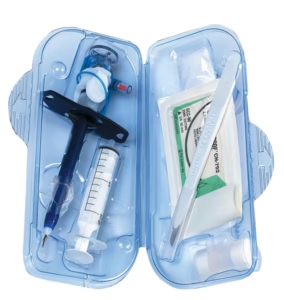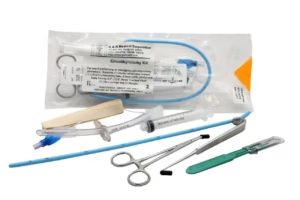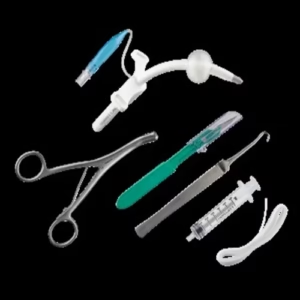The Cricothyrotomy Kit: The Final Option When Seconds Count
In the hierarchy of airway management, there is a point of no return—a moment when all conventional methods have failed and a life hangs in the balance. This is the "Can't Intubate, Can't Oxygenate" (CICO) scenario, the most feared emergency in anesthesia and critical care. It is in this dire moment that the cricothyrotomy kit transforms from a sterile package into a patient's only hope.

This post explores the contents, purpose, and profound importance of this ultimate emergency airway device.
The CICO Scenario: Why This Kit Exists
A cricothyrotomy is an emergency surgical procedure that creates an airway directly through the cricothyroid membrane in the neck. It is not an elective procedure. It is the definitive, final step in a failed airway algorithm when:
- Mask Ventilation is Impossible: The patient's face cannot be sealed (e.g., massive facial trauma, beard, obesity).
- Endotracheal Intubation has Failed: Multiple attempts to place a breathing tube have been unsuccessful, and the patient is becoming hypoxic.
- Supraglottic Airway Devices have Failed: Devices like the LMA have either failed to insert or are not providing adequate ventilation.
In this scenario, the brain can survive without oxygen for only a matter of minutes. The cricothyrotomy kit is designed to establish a patent airway in under 60-90 seconds.
Anatomy in a Nutshell: The Target Zone
The entire procedure hinges on one small, critical landmark: the cricothyroid membrane. This is a soft, avascular patch of tissue located between the thyroid cartilage (the prominent "Adam's apple") and the cricoid cartilage (the hard ring below it). It is the most superficial and accessible part of the airway, making it the ideal entry point for a rapid surgical airway.
Anatomy of a Cricothyrotomy Kit: The Tools of Salvation
A pre-packaged cricothyrotomy kit is designed for speed, simplicity, and success under extreme pressure. It contains everything needed to perform the procedure in one sterile, organized tray. While contents vary slightly by manufacturer, they typically include the following essential components:
1. The Scalpel:
- Purpose: To make the incisions. Kits usually contain a #10 or #11 blade. The #10 blade is used for a larger vertical skin incision, while the #11 blade's pointed tip is ideal for the precise horizontal stab through the cricothyroid membrane itself.
2. The Tracheal Hook:
- Purpose: This is a critical but often-overlooked tool. After the incision is made, the hook is used to grasp the inferior edge of the thyroid cartilage and pull it upwards. This action stabilizes the larynx and lifts the trachea, making it easier to insert the tube and preventing it from disappearing into the neck tissue.

3. The Introducer or Dilator:
- Purpose: After the membrane is pierced, the airway opening needs to be widened to accept the tube. A Trousseau dilator or a firm introducer is inserted and opened to create a clear passage, preventing the tube from being misplaced or creating a false passage.
4. The Cricothyrotomy Tube:
- Purpose: This is not a standard endotracheal tube. It is specially designed for this procedure:
- Short: It only needs to bridge the small distance from the skin to the trachea.
- Wide: A larger inner diameter (e.g., 6.0 mm) is crucial to minimize the work of breathing and allow for effective ventilation.
- Cuffed: It has an inflatable balloon to create a seal within the trachea, allowing for positive-pressure ventilation and protecting the airway from blood or secretions.
5. Syringe:
- Purpose: A small 10ml syringe used to inflate the cuff on the cricothyrotomy tube once it is in place.
6. Securing Device:
- Purpose: A cloth strap or a commercial holder to firmly secure the tube around the patient's neck, preventing accidental dislodgement.
The Procedure in Principle (Simplified)
While formal training is mandatory, the concept is straightforward:
- Identify: Palpate the neck to find the thyroid cartilage, the cricoid cartilage, and the soft spot (membrane) in between.
- Incise: Make a vertical midline incision through the skin. Then, make a horizontal stab incision through the cricothyroid membrane.
- Dilate & Insert: Insert the tracheal hook to lift the larynx. Use the dilator to widen the opening, then slide the cricothyrotomy tube (with its obturator) into the trachea.
- Confirm: This is the most critical step. Remove the obturator, inflate the cuff, and attach a bag-valve mask. Confirm placement by looking for bilateral chest rise, listening for breath sounds, and—most importantly—by observing a square-wave capnography tracing, which is the gold standard for confirming the tube is in the trachea.
- Secure: Once confirmed, secure the tube with the provided strap.
Needle vs. Surgical Cricothyrotomy
It's important to distinguish between the two:
- Needle Cricothyrotomy: Involves placing a large-bore IV catheter through the membrane. This can provide temporary, low-pressure oxygenation (often via a jet ventilator) but is inadequate for ventilation due to the catheter's small diameter and high resistance. It is a bridge to a definitive surgical airway.
- Surgical Cricothyrotomy: The procedure performed with the kit described above. It creates a large enough opening for a cuffed tube, allowing for effective, long-term ventilation.

Conclusion
The cricothyrotomy kit sits in its packaging, a silent sentinel in operating rooms, ICUs, and ambulances. It represents the ultimate safety net in medicine—a promise that even when all else fails, there is a final, decisive action that can be taken. It is a testament to the principle that in medicine, preparation for the worst-case scenario is not pessimism; it is the highest form of patient advocacy.



